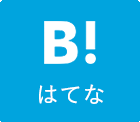Combining traditional Japanese craftsmanship with modern designs
The Japanese art and culture magazine, Waraku Magazine, has been launching new projects in honor of our 15th anniversary, and our Waraku × Tokyo Teshigoto Project has come to fruition! We are teaming up with local craftsmen to offer special items produced by using traditional Japanese artisanal techniques, including a line-up of 招き猫 (maneki neko, fortune cat or beckoning cat) sporting an array of colorful fabrics.
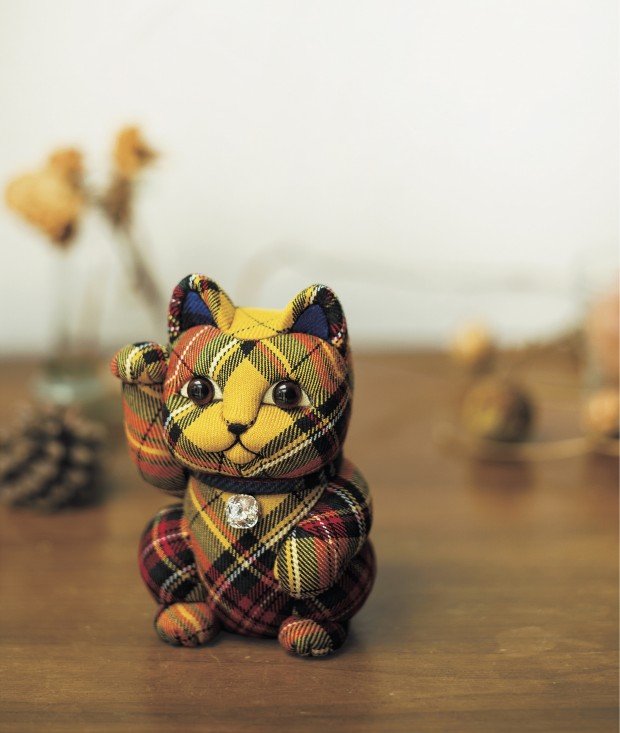
As soon as we introduced our maneki neko in the August ・ September 2016 issue of Waraku Magazine, our feline friend became quite the hot topic. A flurry of inquiries followed, “Where can I get this cat?”, “When will it be available for purchase?” Without further ado, we are happy to announce that the much-talked about “Fortune Cat” is on sale at Ginza Mitsukoshi in addition to the Shogakukan’s online goods shop, PalShop.
While the variety of cats now include fabrics from Missoni, Liberty, and more, below we introduce the very first, original line up of the Fortune Cat series. Featuring a coat of tartan check or animal print, this cute fortune cat makes a lasting impression after just one glance, doesn’t it?
Presenting Waraku’s original maneki neko, the “Fortune Cat”
The name for our collaborative product is called Fortune Cat, and its name in Japanese uses the character for fortune, 福 (fuku), and cat, 猫 (neko). Its upraised paw ushers in good fortune, but its cute design and colorful patterns will also give you something to smile about.
Aside from the yellow tartan pattern seen in the photographs above and below, there is also a blue tartan and an animal print pattern for a total line up of 3 different color options. Depending on which fabric is used and also how the fabric is applied, the patterning and final appearance varies from each cat to cat. In addition, since each maneki neko is handmade, no two cats are identical. Look for these lucky kitties at the Japan Edition shop on the 7th floor of Ginza Mitsukoshi. They are priced at 10,000 each, not including tax.
This is the secret behind Waraku’s maneki neko’s creation!
As previously mentioned, as part of our Tokyo Teshigoto Project x Waraku collaboration to share with the world tasteful products featuring modern designs and created using traditional Japanese artisanal techniques, an absolutely adorable, original maneki neko has arrived. These cat dolls are produced by using a traditional doll-making technique, and each cat is one by one, handcrafted by skilled artisans. Let’s take a closer look!
Back
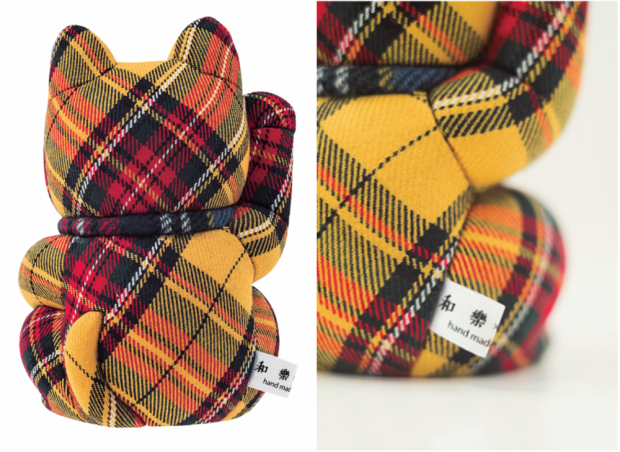
Shh, don’t call it short and stout! This almost perfectly round, plump, and happy-looking body exudes an air of adorableness. It is in the carefully tucked in fabric of the curved tail that you can see and marvel at the expertise of the wooden doll
木目込み人形 (kimekomi ningyo, wooden dolls decorated with fabric tucked into grooves) craftsmen.
Here is the proof of our handiwork, a custom tag
And finally, you can also see from the pictures that we have attached a custom-made tag with “Waraku × Tokyo Teshigoto” written in Japanese characters. Just like the little tag on a traditional teddy bear toy, we have also included a “Waraku × Tokyo Teshigoto” tag to guarantee the quality of these traditional craft works.
Side
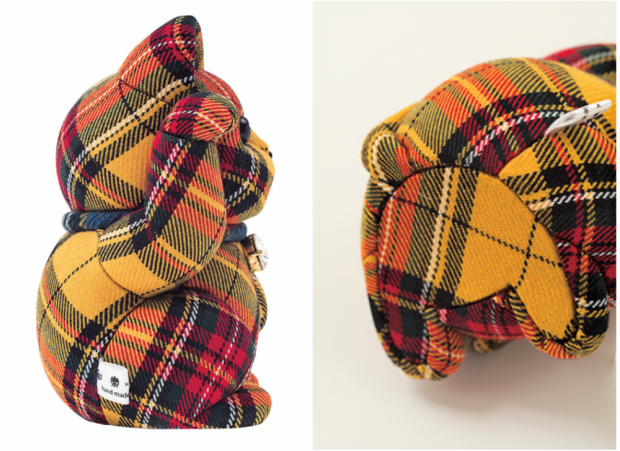
This cat also looks very charming from the side. Again, its round and chubby shape merits attention. Or should we say it is what makes our furry friend all the more cuter? It is said that with its right paw raised, the maneki neko is beckoning in economic fortune. We decided to use tartan check and an animal print coat to bring out the kitty’s cuteness.
The techniques used to make traditional kimekomi dolls really shine in the details
Edo kimekomi ningyo are a type of traditional doll originating from the Edo period. The name is derived from the techniques used to fashion these lovely dolls. 木 (Ki) means wood, and 目込み (mekomi) refers to the process of tucking in, in this case, fabric. First, lines are carved into the wooden or wood compound base of the doll. Rice paste glue is applied to each section one at a time, and pieces of fabric carefully selected and cut to match each section are laid over their corresponding section. The edges of the fabric are tucked into the grooves with special skill to ensure no wrinkling of the fabric. It is in the fine detailed areas like the fortune cat’s nose, mouth, eyes, and tail as well as the matching of fabric patterns that the sensitivity of the artisans comes through.
Front
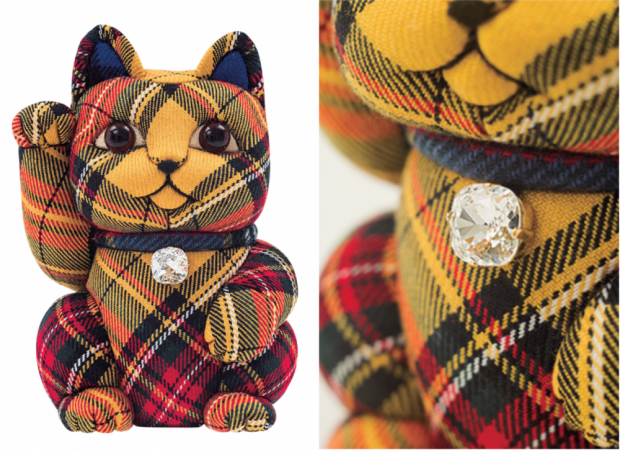
With this cute face, you can’t help but want this cat for your own. Measuring 13 cm in height × 8.5 cm in width × 7.5 cm in depth, the fortune cat offers a nonchalant presence within any interior space. The plump cheeks are the highlight of this maneki neko’s design, which was created by Mr. Kakinuma, the president of the Kakinuma Ningyo doll-making shop.
What’s that sparkle? A little shine from Swarovski
The fortune cat’s chest is decorated with an extravagant Swarovski crystal instead of the usual bell. Glittering in the light, this little charm adds a special touch and a feeling of luck to our harbinger of good fortune.
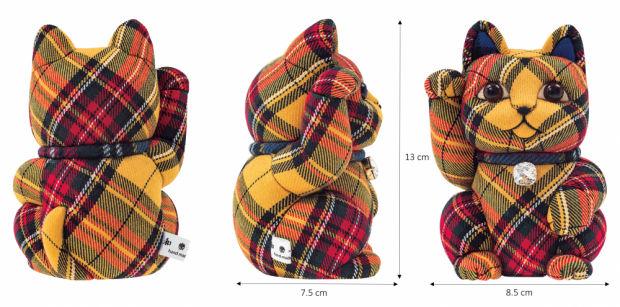
Our maneki neko story
We at Waraku tried to make an updated version with a more modern feel of the Edo-period (1603-1868) lucky charm or talisman known as maneki neko. And so, in the spring of this year, we began the collaborative “Maneki Neko Project” with Tokyo Teshigoto. Who are our partners? Tokyo Teshigoto was started by the Tokyo Metropolitan Small and Medium Enterprise Support Center in 2015. The project comprises of small companies within the Tokyo Metropolitan area who support and team up with traditional Japanese artisans.
Together these teams complement traditional techniques and aesthetics with fresh, modern designs to create unique products that appeal to people both within and outside of Japan. One of the items that resulted from our activities with this initiative is the newly designed maneki neko with the Edo kimekomi ningyo-makers at Kakinuma Ningyo. These craftsmen have displayed their works at overseas trade fairs such as At Maison & Objet held in Paris and Ambiente in Frankfurt to great acclaim.
It is with these skilled artisans of Kakinuma Ningyo with Tokyo Teshigoto that Waraku, who also wants to support traditional arts and crafts, met and excitedly decided to produce a maneki neko with the aim of spreading an appreciation for traditional crafts within Japan and abroad.
First we started with the selection of the fabric. We aimed for prints that would suit well with present-day interiors and would also be well-received abroad, and in the end, we selected two tartan check patterns and an animal print pattern. The finished product appears simple in design, but each fortune cat requires 20 pieces of fabric, and each of these pieces of cloth are carefully tucked into the wooden doll using traditional techniques by skilled Edo kimekomi doll makers. Only the inner parts of the ear and the collar use different fabrics from the rest of the cat and serve as accents. Finally, a glittering Swarovski crystal is added to the chest area to complete an unforgettable, fortune-calling maneki neko!
Curious about where maneki neko came from?
Discover the origins of the maneki neko and spots in Tokyo associated with the lucky cat with our videos and other articles!
Gotokuji Temple | in Tokyo
Offering incense | Did you know?
Read more about the maneki neko’s beginnings, Gōtokuji Temple, and Imado Shrine, too!












